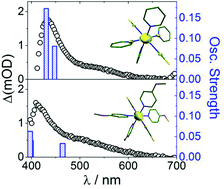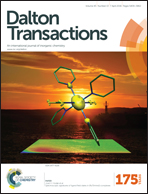Spectroscopic signatures of ligand field states in {RuII(imine)} complexes†
Abstract
Ligand field (LF) states have been present in discussions on the photophysics and photochemistry of ruthenium-iminic chromophores for decades, although there is very little documented direct evidence of them. We studied the picosecond transient absorption (TA) spectroscopy of four {RuII(imine)} complexes that respond to the formula trans-[Ru(L)4(X)2], where L is either pyridine (py) or 4-methoxypyridine (MeOpy) and X is either cyanide or thiocyanate. Dicyano compounds behave as most ruthenium polypyridines and their LF states remain silent. In contrast, in the dithiocyanate complexes we found clear spectroscopic evidence of the participation of LF states in the MLCT decay pathway. These states are of donor and acceptor character simultaneously and this is manifested in the presence of MLCT and LMCT transient absorption bands of similar energy. Spectroelectrochemical techniques supported the interpretation of the absorption features of MLCT states, and DFT methods helped to assign their spectroscopic signatures and provided strong evidence on the nature of LF states.



 Please wait while we load your content...
Please wait while we load your content...